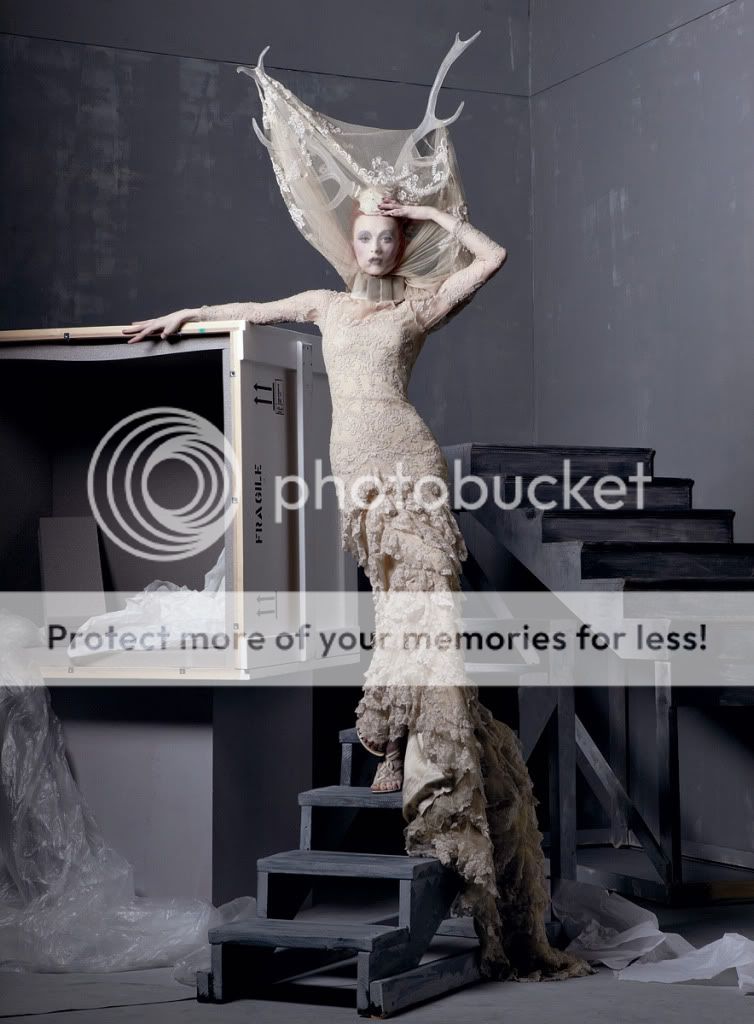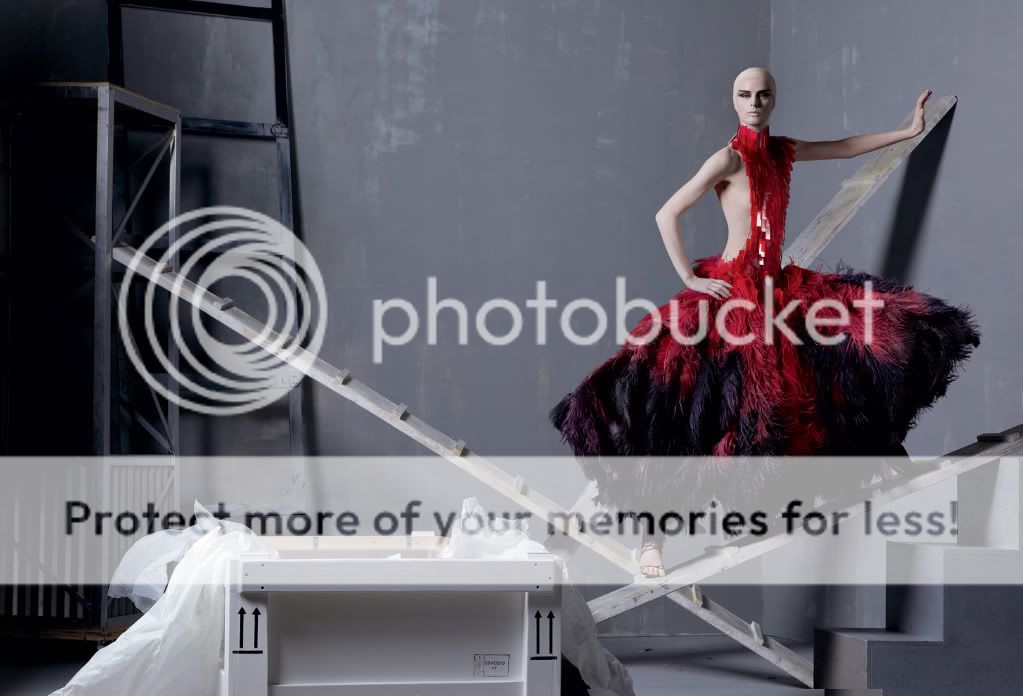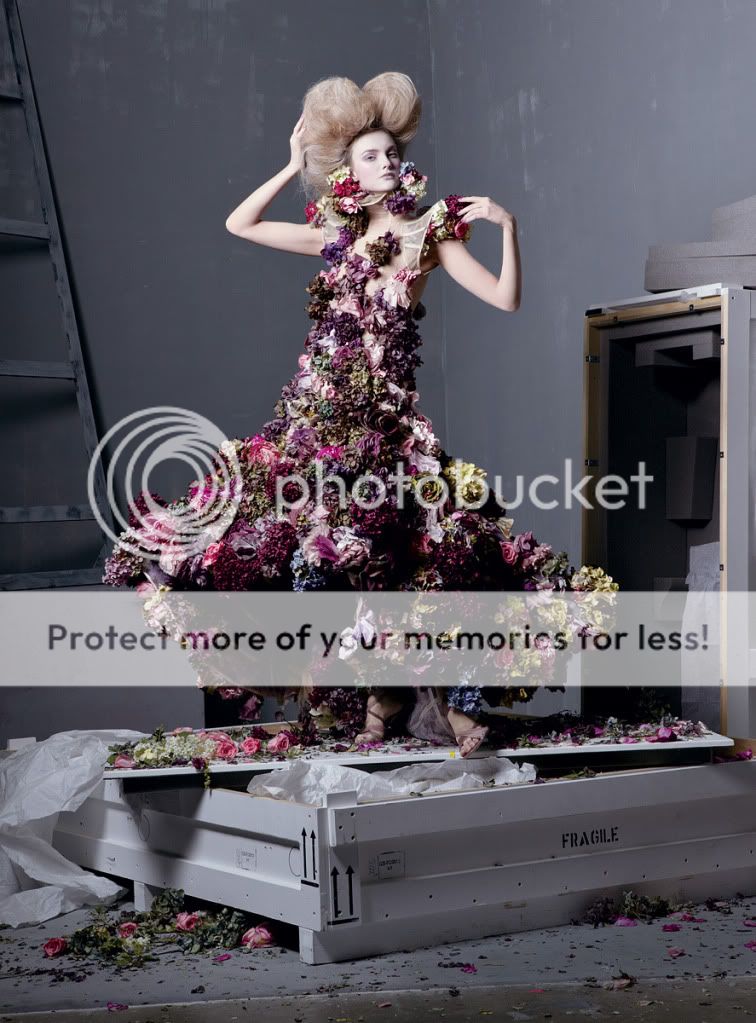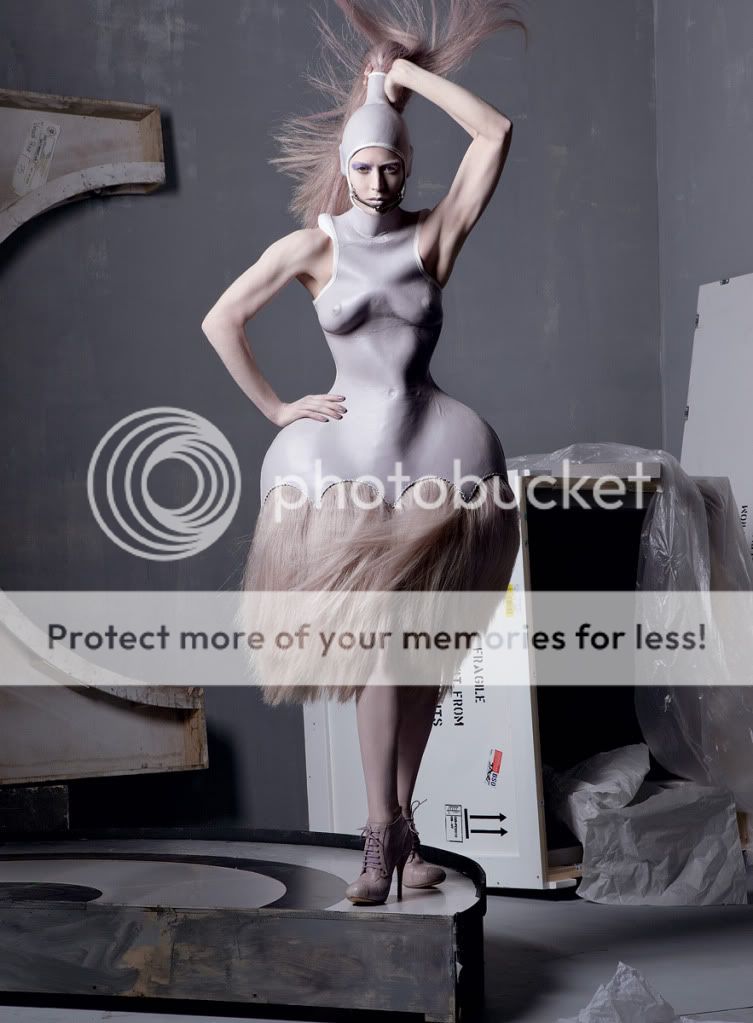-
Live Streaming... The S/S 2026 Fashion Shows
New York Fashion Week S/S 2026 Show Schedule -
MODERATOR'S NOTE: Please can all of theFashionSpot's forum members remind themselves of the Forum Rules. Thank you.
You are using an out of date browser. It may not display this or other websites correctly.
You should upgrade or use an alternative browser.
You should upgrade or use an alternative browser.
Costume Institute Gala 2011 : Alexander McQueen : Savage Beauty
- Thread starter rox_yr_sox
- Start date
Chanelcouture09
Some Like It Hot
- Joined
- Feb 20, 2009
- Messages
- 10,572
- Reaction score
- 34
Alexander McQueen Retrospective Bows at the Met
by MARC KARIMZADEH
NEW YORK — Web rumors swirled on Thursday that Alexander McQueen’s Sarah Burton may indeed have been tapped by Kate Middleton to design her historic wedding gown. Whether or not this morning’s London festivities prove true that speculation, this is a golden moment for the house of McQueen as the genius of its founder goes on view at the Metropolitan Museum of Art. “Alexander McQueen: Savage Beauty” launches at Monday night’s Costume Institute Gala and opens to the public on Wednesday.
McQueen’s challenge of traditional ideas of beauty is as renown as his mastery of craftsmanship and the drama of his garments and runway spectacles. The exhibit marries these notions seamlessly in its exploration of the complex and creative world of the designer, who took his own life in February 2010. It addresses the themes that informed McQueen’s work including life and death, gender and sexuality and race and religion, as well as a reverence for 19th-century romanticism and an irreverent hand with fashion convention. The exhibit also highlights plenty of examples of McQueen’s most famous runway moments, from the fall 2003 billowing cape shown in an artificial wind tunnel to the spray-painted, white cotton muslin dress worn by Shalom Harlow from spring 1999 and a miniature version of the Kate Moss hologram that ended his fall 2006 show.
The exhibition features about 100 pieces from McQueen’s London archive and the Paris archives of Givenchy as well from the late Isabella Blow’s wardrobe, which Daphne Guinness bought last year and loaned to the museum. It opens with two looks from McQueen’s spring 2001 “Voss” collection: a dress from ostrich feathers and painted red medical slides and another dripping in razor-clam shells.
“McQueen would challenge normative conventions of beauty,” said Andrew Bolton, who curated the show at the museum’s Cantor Galleries with the support of Harold Koda. “Voss’ fetishized materials, silhouettes and themes were iconic to McQueen.”
The powerful opening leads to a stylized recreation of McQueen’s first atelier in London’s Hoxton neighborhood. Here, the famous bumster trousers and skirts are featured along with pieces from his “Jack the Ripper Stalks His Victims” graduation collection including a silk satin jacket lined with red silk and human hair. A gallery called “Cabinet of Curiosities” showcases Philip Treacy headdresses and Shaun Leane jewels alongside looks such as a golden, armorlike dress from the designer’s days at Givenchy, a molded plastic bodice laced with realistic-looking worms, and the hand-carved prosthetic legs Aimee Mullins wore for the spring 1999 “No.13” show. “In a way, it’s the soul of this show,” Bolton said of this gallery. “The curious pieces show Lee’s more provocative and confrontational side. You also see his love of craft, and how he advanced fashion by embracing complex ideas.”
The “Romantic Nationalism” gallery juxtaposes tartan looks from the fall 1995 “Highland r*pe” with those from “Widows of Culloden” for fall 2006.
The show ends with a lineup from “Plato’s Atlantis,” McQueen’s last complete collection, which touched on “the devolution of mankind rather than the evolution,” Bolton said. “I wanted to end with this because I feel that it brings everything together. It was the balance of craftsmanship and conceptualism, which is what McQueen was about.”
Sam Gainsbury and Joseph Bennett, who helped produce McQueen’s runway shows, consulted on the show, and Guido Palau created head designs that underscore McQueen’s often fetishistic designs.
François-Henri Pinault and Salma Hayek will serve as the gala’s honorary chairs, with Colin Firth, Stella McCartney and Anna Wintour as co-chairs.
wwd
by MARC KARIMZADEH
NEW YORK — Web rumors swirled on Thursday that Alexander McQueen’s Sarah Burton may indeed have been tapped by Kate Middleton to design her historic wedding gown. Whether or not this morning’s London festivities prove true that speculation, this is a golden moment for the house of McQueen as the genius of its founder goes on view at the Metropolitan Museum of Art. “Alexander McQueen: Savage Beauty” launches at Monday night’s Costume Institute Gala and opens to the public on Wednesday.
McQueen’s challenge of traditional ideas of beauty is as renown as his mastery of craftsmanship and the drama of his garments and runway spectacles. The exhibit marries these notions seamlessly in its exploration of the complex and creative world of the designer, who took his own life in February 2010. It addresses the themes that informed McQueen’s work including life and death, gender and sexuality and race and religion, as well as a reverence for 19th-century romanticism and an irreverent hand with fashion convention. The exhibit also highlights plenty of examples of McQueen’s most famous runway moments, from the fall 2003 billowing cape shown in an artificial wind tunnel to the spray-painted, white cotton muslin dress worn by Shalom Harlow from spring 1999 and a miniature version of the Kate Moss hologram that ended his fall 2006 show.
The exhibition features about 100 pieces from McQueen’s London archive and the Paris archives of Givenchy as well from the late Isabella Blow’s wardrobe, which Daphne Guinness bought last year and loaned to the museum. It opens with two looks from McQueen’s spring 2001 “Voss” collection: a dress from ostrich feathers and painted red medical slides and another dripping in razor-clam shells.
“McQueen would challenge normative conventions of beauty,” said Andrew Bolton, who curated the show at the museum’s Cantor Galleries with the support of Harold Koda. “Voss’ fetishized materials, silhouettes and themes were iconic to McQueen.”
The powerful opening leads to a stylized recreation of McQueen’s first atelier in London’s Hoxton neighborhood. Here, the famous bumster trousers and skirts are featured along with pieces from his “Jack the Ripper Stalks His Victims” graduation collection including a silk satin jacket lined with red silk and human hair. A gallery called “Cabinet of Curiosities” showcases Philip Treacy headdresses and Shaun Leane jewels alongside looks such as a golden, armorlike dress from the designer’s days at Givenchy, a molded plastic bodice laced with realistic-looking worms, and the hand-carved prosthetic legs Aimee Mullins wore for the spring 1999 “No.13” show. “In a way, it’s the soul of this show,” Bolton said of this gallery. “The curious pieces show Lee’s more provocative and confrontational side. You also see his love of craft, and how he advanced fashion by embracing complex ideas.”
The “Romantic Nationalism” gallery juxtaposes tartan looks from the fall 1995 “Highland r*pe” with those from “Widows of Culloden” for fall 2006.
The show ends with a lineup from “Plato’s Atlantis,” McQueen’s last complete collection, which touched on “the devolution of mankind rather than the evolution,” Bolton said. “I wanted to end with this because I feel that it brings everything together. It was the balance of craftsmanship and conceptualism, which is what McQueen was about.”
Sam Gainsbury and Joseph Bennett, who helped produce McQueen’s runway shows, consulted on the show, and Guido Palau created head designs that underscore McQueen’s often fetishistic designs.
François-Henri Pinault and Salma Hayek will serve as the gala’s honorary chairs, with Colin Firth, Stella McCartney and Anna Wintour as co-chairs.
wwd
TREVOFASHIONISTO
Active Member
- Joined
- Jun 2, 2008
- Messages
- 15,357
- Reaction score
- 66
cannot wait to go
liberty33r1b
Well-Known Member
- Joined
- Nov 9, 2003
- Messages
- 24,331
- Reaction score
- 746
Empress of Dress
Member
- Joined
- Dec 26, 2010
- Messages
- 61
- Reaction score
- 15
I am blown away buy his works. Simply Beyond
shopping247
Active Member
- Joined
- Dec 20, 2005
- Messages
- 1,919
- Reaction score
- 0
i can't wait to check out this exhibit as well. it's a once-in-a-lifetime opportunity to see his special pieces IRL, hopefully upclose and personal. :-)
get fashion
Active Member
- Joined
- Jul 16, 2010
- Messages
- 2,018
- Reaction score
- 4
Such an amazing exhibition, McQueen forever.
softgrey
flaunt the imperfection
- Joined
- Jan 28, 2004
- Messages
- 52,984
- Reaction score
- 411
thanks...thread one is so much better...
just the HQ's...
 ...
...
went to the show...
it's excellent...
the room sets may be the best bit...
all done by the mcQueen production team...
it's also fascinating to note where the clothing was loaned from...
some major fashion editors seem to have loaned their personal pieces...
including Katy England...
they have quotes from mcqueen all around as well...
the whole thing is very dark...
i mean that in every way possible...
it's dark...very dark...
but it's very very good...
i'm sure i'll go back...
everyone---GET THE BOOK!!!
it's the best...
those are not mannequins the clothes are shot on...
they are photoshopped models with white make up and jointed hands and heads to make them appear to be mannequins...
but mannequins don't MOVE like that!!!...

shot by solve sundsbo...
xxx
softie
just the HQ's...
 ...
...went to the show...
it's excellent...
the room sets may be the best bit...
all done by the mcQueen production team...
it's also fascinating to note where the clothing was loaned from...
some major fashion editors seem to have loaned their personal pieces...
including Katy England...
they have quotes from mcqueen all around as well...
the whole thing is very dark...
i mean that in every way possible...
it's dark...very dark...
but it's very very good...
i'm sure i'll go back...
everyone---GET THE BOOK!!!
it's the best...
those are not mannequins the clothes are shot on...
they are photoshopped models with white make up and jointed hands and heads to make them appear to be mannequins...
but mannequins don't MOVE like that!!!...

shot by solve sundsbo...
xxx
softie
Last edited by a moderator:
Similar Threads
- Replies
- 16
- Views
- 11K
- Replies
- 65
- Views
- 23K
- Replies
- 43
- Views
- 12K
- Replies
- 91
- Views
- 28K
Users who are viewing this thread
Total: 1 (members: 0, guests: 1)
New Posts
-
-
-
Elle China October 2025 : Lina Zhang by Liu Song & Zheng Qinwen by Nick Yang (5 Viewers)
- Latest: TerraVera
-
-































 ...
...